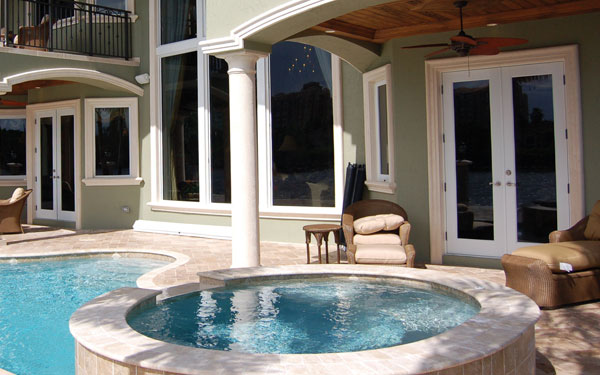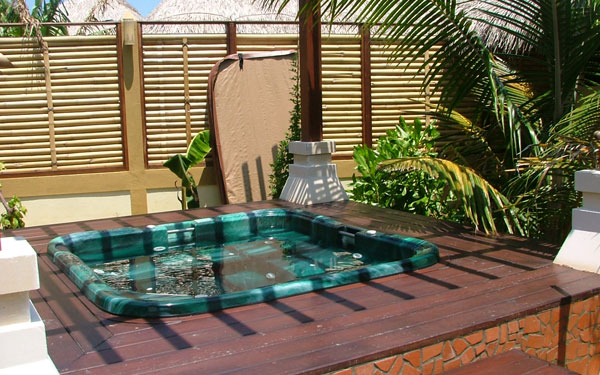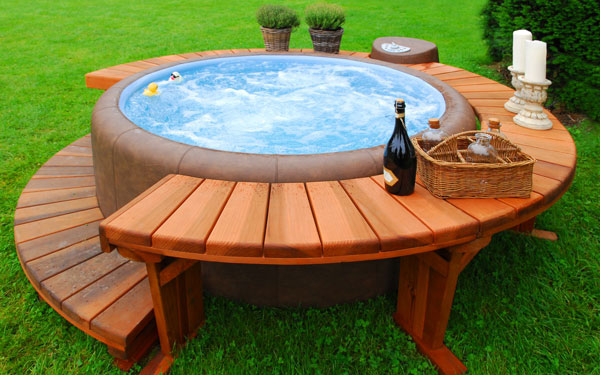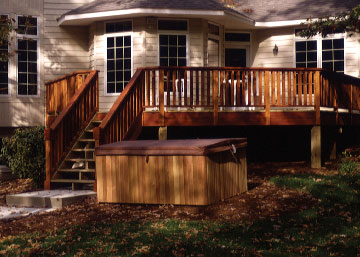 by Jennifer Jones
by Jennifer Jones

View This House Plan
View Other House Plans with Hot Tubs
Nothing screams luxury and relaxation like a soothing hot tub. It is the ultimate in comfort for your backyard or bathroom as well as the perfect place to entertain and unwind. Also known as a spa or Jacuzzi, hot tubs are small pools that are filled with hot water and most have jets for massaging purposes. They are intended for meditating, calming, massaging and hydrotherapy. Hot tubs are perfect for easing pains, loosening muscles and can even help with congestion. The hot water increases circulation and lowers blood pressure, making them the perfect addition for relaxation in your home.

Regardless of the regional climate, hot tubs are most commonly located outdoors. Many homeowners will shelter it for protection from the elements as well as added privacy. However, indoor hot tubs are available and are more often referred to as “spas” when located inside the home. For outdoor hot tubs, it is most advantageous to position it at the closest distance to the home as possible on a flat surface. Some people build a deck that surrounds the hot tub for safety and convenience. Certain hot tubs are warmed with a wood fire heater, while most need to have access to electricity to warm the tub. Therefore, a nearby electrical outlet is required for electric and natural gas heaters. Additionally, the National Electric Code requires the power cutoff switch to be positioned at least 5 feet away from the hot tub.
For the perfect hot tub that best suites your home, there are a few different styles to consider:

Soaking Wooden Hot Tubs – This hot tub design is assembled from wooden planks, also called staves, and held together with steel bands in a form of a large barrel. The staves are usually constructed from cedar, redwood or teak wood. Since they are in barrel form, these tubs are generally deeper with taller walls making it more comfortable for taller people. A wooden bench surrounds the interior circumference of the tub for convenient seating. Many people build a wooden deck around the tub for ease when entering and exiting. It is usual that wooden hot tubs may leak for the first few days of initial use as the wood absorbs the water and expands to fill the gaps. The main downfall of wooden hot tubs is the chance of decomposition since it is mostly constructed of wood. This can be avoided by periodically draining the tub in order to prevent decay and help eliminate bacteria.
Plastic Hot Tubs – These hot tubs are the most popular on the market today. They are less expensive to produce, more energy efficient and easier to install. Jacuzzi hot tubs and spas are molded in one full piece out of fiberglass reinforced plastic material. They are available in a variety of different shapes that provide different seating arrangements inside the tub. They are equipped with several water jets, usually one or more per seat, that flow water onto various parts of the body. These hot tubs can require one to four water pumps with one performing the circulation of water and filtration, while the others power the water jets. Most updated models of plastic hot tubs include sophisticated computer controls that can adjust the water flow as well as move and rotate the jets for a massage-like feeling. Some are so technologically savvy that they come complete with lighting, sound systems, flat screen televisions and DVD players.
Stainless Steel Insulated Hot Tubs – The interior of this hot tub design is a stainless steel base that is usually surrounded with cedar wood for support. This provides extra durability as well as supports better hygienic advantages with the use of stainless steel. The steel suppresses the collection of bugs and is easier to clean than plastic and wood based tubs. Many stainless steel hot tubs are warmed by a steel burner that is powered by a wood fire and can take up to three hours to heat up. It is best to used salt water or pure water with no added chemicals with these tubs.
Indoor Hot Tubs – These designs are a bit smaller than outdoor tubs so they can be installed into an ordinary bathroom. Indoor tubs or spas are similar to a common bathtub and are filled with fresh hot water from the faucet. Since they are drained after every use, indoor tubs have no need for a filtration or heating system. Indoor spas are favorites among homeowners who are fitness fans to relax sore muscles after workouts as a form of hydrotherapy. They are also excellent for any person who just really enjoys a hot, soothing soak in a comforting bath.

View This House Plan
View Other Luxury House Plans
Maintenance
Proper maintenance and sanitation is very important to keep a hot tub running smoothly and healthy. It is proper to check and test the hot tub water daily and establish a routine for managing your hot tub. This will include periodically cleaning the filters and chemical replacement as well as draining and refilling the tub. Since bacteria and other harmful organism thrive in warm, wet conditions, proper water sanitization is vital for a well-kept tub. The addition of chemicals to the water helps balance the pH and alkalinity levels for safe usage as well as prevents damage to the tub. Wear protective clothing and always wash your hands when working with chemicals. The directions should be read carefully, never mix chemicals and only add them to the water when the tub is not in use. They should be applied in a well-ventilated area and stored in a heat-free, dry space that is away from children and pets. If you hot tub is very dirty, it may be time to drain completely, scrub with a cleanser, rinse out and refill.
Temperature
The safest water temperature for a hot tub is 98°F. This is the same temperature as the human body and poses no risk of fever. 104°F is the maximum temperature for adults to be safe in water according to the National Spa and Pool Institute. They recommend soaking for no longer than 15 minutes at this temperature. Too much exposure to hot water can harm your organs, cause drowsiness and produce fever-like ailments. Older children should not be allowed to soak in a hot tub that is more than 95°F for more than 10 minutes as well as should never be left unattended. Hot tubs are not suitable for children under the age of four. Additionally, pregnant women should be very careful of overheating which could damage the baby and consider refraining from hot tub use entirely. Consult a doctor before hot tub usage if you have a history of diabetes, heart disease, low or high blood pressure as well as any another serious illness.
View This House Plan to the left
Safety
Proper safety precautions should be taken when using a hot tub that are similar to rules regarding pools, lakes and other bodies of water. For the safety of your family and friends, be familiar with the following precautions when soaking in your hot tub:
-
Before entering the hot tub, shower with soap to wash away lotions, skin bacteria and other skin coatings that compromise the sanitation of the hot tub water.
-
To prevent spreading infections, people with open sores, wounds and other skin and body infections should refrain from using the hot tub.
-
Be sure to stay hydrated when in a hot tub and drink plenty of water.
-
If an allergic reaction occurs during hot tub use, exit immediately, rinse off in a shower and consider consulting a doctor.
-
Avoid hot tub usage when alone, after a heavy meal, after exercising or under the influence of alcohol, narcotics and other drugs that cause drowsiness.
-
Relaxed muscles can cause unsteadiness and decks as well as hot tub steps can be slippery, so be careful when getting into and out of the hot tub.
-
To prevent disease and drowning, do not submerge your head under the water. Water in the mouth can be infectious and the suction can dangerously entangle hair in drains.
-
Refrain from using glass in and around the hot tub. Broken glass is difficult to see in the water and can cause harm to bare feet and skin.
-
Keep all electrical equipment and devices at a safe distance from the water, including phones, televisions and radios.
-
Install handrails in proper locations to assist with entering and exiting the tub.
-
The drains in the tub should have safety covers and the hot tub cover should be secured and locked when not in use.
-
The hot tub needs electricity to run cleaning cycles, so always leave the power switched on, except when changing water or filters.
Whether you call it a Jacuzzi, spa or hot tub, this desirable addition to your home can provide the ultimate relaxation. Some homeowners will have a hot tub in addition to their pool for plenty of entertainment options. Others prefer personal spas in their bathroom for private recreation. So if you feel the need to lower your blood pressure and relax those tense and sore muscles, a hot tub may be the perfect investment for you.
Here are some related articles:
Save this article to:
back to top